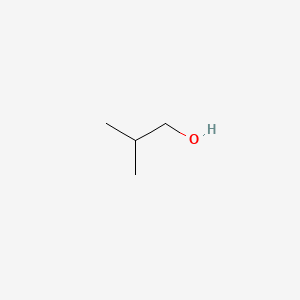| Wojtków D and Czarnecki MA |
Effect of temperature and concentration on the structure of sec-butyl alcohol and isobutyl alcohol/water mixtures: near-infrared spectroscopic study. |
2006 |
J Phys Chem A |
pmid:16956236
|
|
|
|
|
pmid:16942999
|
|
|
|
|
pmid:16928017
|
| Jeong GT et al. |
Application of two-stage biofilter system for the removal of odorous compounds. |
2006 |
Appl. Biochem. Biotechnol. |
pmid:16915714
|
| Boyd GR et al. |
Effects of initial saturation on properties modification and displacement of tetrachloroethene with aqueous isobutanol. |
2006 |
J. Contam. Hydrol. |
pmid:16904790
|
|
|
|
|
pmid:16889859
|
|
|
|
|
pmid:16860421
|
|
|
|
|
pmid:16618201
|
| Wang P et al. |
Enantiomeric resolution of chiral pesticides by high-performance liquid chromatography. |
2006 |
J. Agric. Food Chem. |
pmid:16506803
|
| Li H et al. |
Prediction of estrogen receptor agonists and characterization of associated molecular descriptors by statistical learning methods. |
2006 |
J. Mol. Graph. Model. |
pmid:16497524
|
|
|
|
|
pmid:16471634
|
|
|
|
|
pmid:16366707
|
| Boyd GR et al. |
Dip-angle influence on areal DNAPL recovery by co-solvent flooding with and without pre-flooding. |
2006 |
J. Contam. Hydrol. |
pmid:16303209
|
| Xu Y et al. |
Controlled formation of volatile components in cider making using a combination of Saccharomyces cerevisiae and Hanseniaspora valbyensis yeast species. |
2006 |
J. Ind. Microbiol. Biotechnol. |
pmid:16292558
|
| McKee M et al. |
The composition of surrogate alcohols consumed in Russia. |
2005 |
Alcohol. Clin. Exp. Res. |
pmid:16269919
|
|
|
|
|
pmid:16233632
|
|
|
|
|
pmid:16233363
|
|
|
|
|
pmid:16215861
|
|
|
|
|
pmid:16037928
|
|
|
|
|
pmid:15969476
|
| Zhang Q et al. |
Fragmentation pathway for glutamine identification: loss of 73 Da from dimethylformamidine glutamine isobutyl ester. |
2005 |
J. Am. Soc. Mass Spectrom. |
pmid:15922620
|
|
|
|
|
pmid:15910814
|
|
|
|
|
pmid:15849720
|
| Agouridis N et al. |
Malolactic fermentation in wine with Lactobacillus casei cells immobilized on Delignified cellulosic material. |
2005 |
J. Agric. Food Chem. |
pmid:15796593
|
| Radtke CW et al. |
Vapor-phase analysis of isobutyl acetate, isopropyl acetate, n-propyl acetate and their respective alcohols using solid-phase microextraction-gas chromatography with a mass selective detector. |
2005 |
J Chromatogr A |
pmid:15794575
|
|
|
|
|
pmid:15792253
|
|
|
|
|
pmid:15784068
|
| Lachenmeier DW et al. |
Multivariate analysis of FTIR and ion chromatographic data for the quality control of tequila. |
2005 |
J. Agric. Food Chem. |
pmid:15769149
|
|
|
|
|
pmid:15733582
|
| Buzzini P et al. |
Production of volatile organic sulfur compounds (VOSCs) by basidiomycetous yeasts. |
2005 |
FEMS Yeast Res. |
pmid:15691743
|
|
|
|
|
pmid:15479023
|
|
|
|
|
pmid:15478997
|
|
|
|
|
pmid:15468220
|
| Yamamoto K et al. |
N-methylethanolamine attenuates cardiac fibrosis and improves diastolic function: inhibition of phospholipase D as a possible mechanism. |
2004 |
Eur. Heart J. |
pmid:15246640
|
| Franco M et al. |
Off-vine grape drying effect on volatile compounds and aromatic series in must from Pedro Ximénez grape variety. |
2004 |
J. Agric. Food Chem. |
pmid:15186115
|
|
|
|
|
pmid:15162454
|
| Cardoso DR et al. |
Comparison between cachaça and rum using pattern recognition methods. |
2004 |
J. Agric. Food Chem. |
pmid:15161210
|
| Olson ES et al. |
Higher-alcohols biorefinery: improvement of catalyst for ethanol conversion. |
2004 |
Appl. Biochem. Biotechnol. |
pmid:15054242
|
| Wendakoon SK et al. |
Inhibition of acetate ester biosynthesis in banana (Musa sapientum L.) fruit pulp under anaerobic conditions. |
2004 |
J. Agric. Food Chem. |
pmid:15030220
|
|
|
|
|
pmid:14967244
|
|
|
|
|
pmid:14961685
|
| Nelson JE and Krawetz SA |
Purification of cloned and genomic DNA by guanidine thiocyanate/isobutyl alcohol fractionation. |
1992 |
Anal. Biochem. |
pmid:1489096
|
| Kurashima K et al. |
Simple synthesis of beta-D-glycopyranosides using beta-glycosidase from almonds. |
2004 |
Chem. Pharm. Bull. |
pmid:14758017
|
| Fu Y et al. |
Facile synthesis of alpha,alpha-diisobutylglycine and anchoring its derivatives onto PAL-PEG-PS resin. |
2003 |
J. Org. Chem. |
pmid:14656124
|
|
|
|
|
pmid:14637351
|
|
|
|
|
pmid:14302468
|
| Schütz H et al. |
[Experiences with congener analysis of beverages without congeners]. |
1992 |
Blutalkohol |
pmid:1389019
|
| Golovkova NP |
[The evaluation of alternative fuels for automobile transport and the resolution of hygienic and ecological tasks]. |
1992 |
Gig Tr Prof Zabol |
pmid:1385271
|
| Nandi I et al. |
Study of isopropyl myristate microemulsion systems containing cyclodextrins to improve the solubility of 2 model hydrophobic drugs. |
2003 |
AAPS PharmSciTech |
pmid:12916919
|
|
|
|
|
pmid:12903956
|
